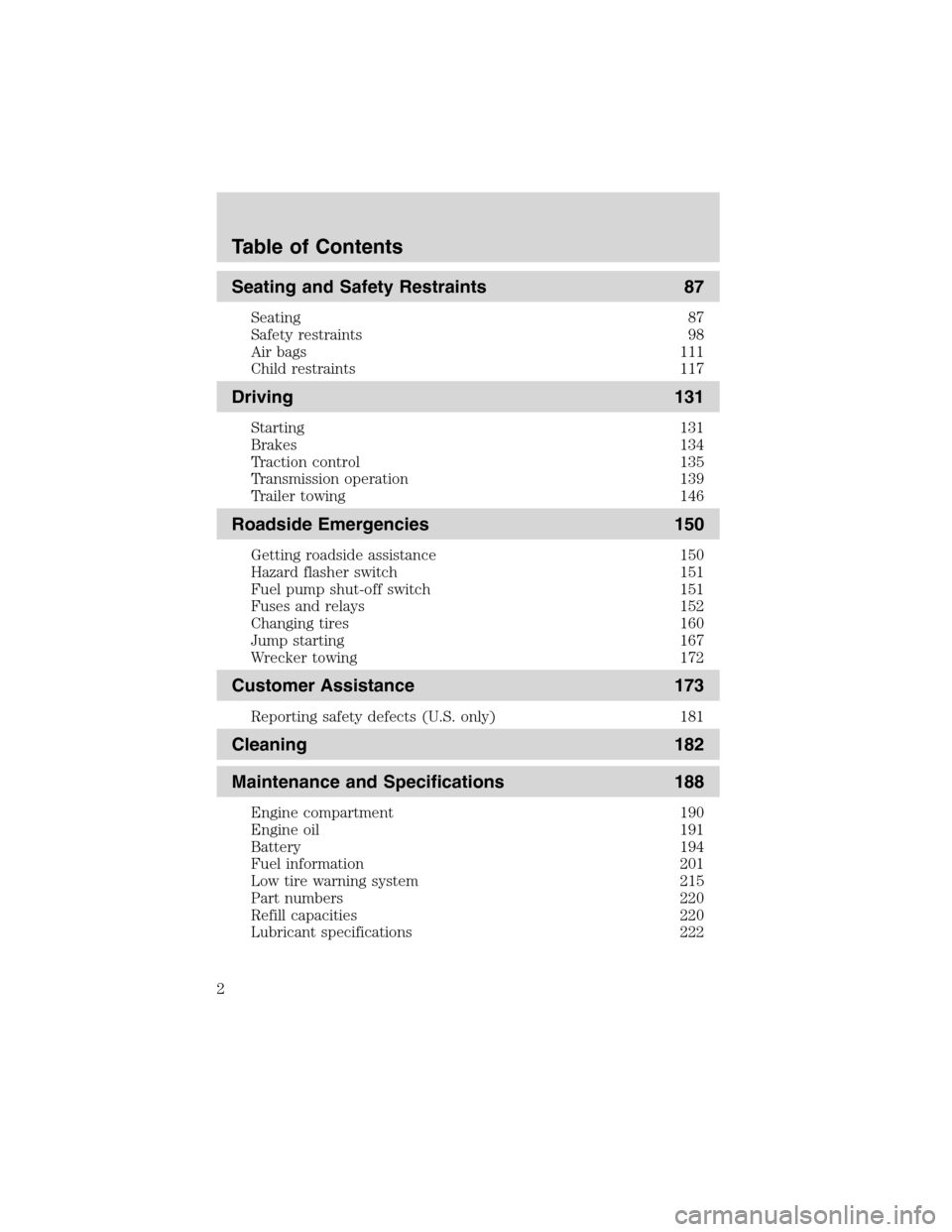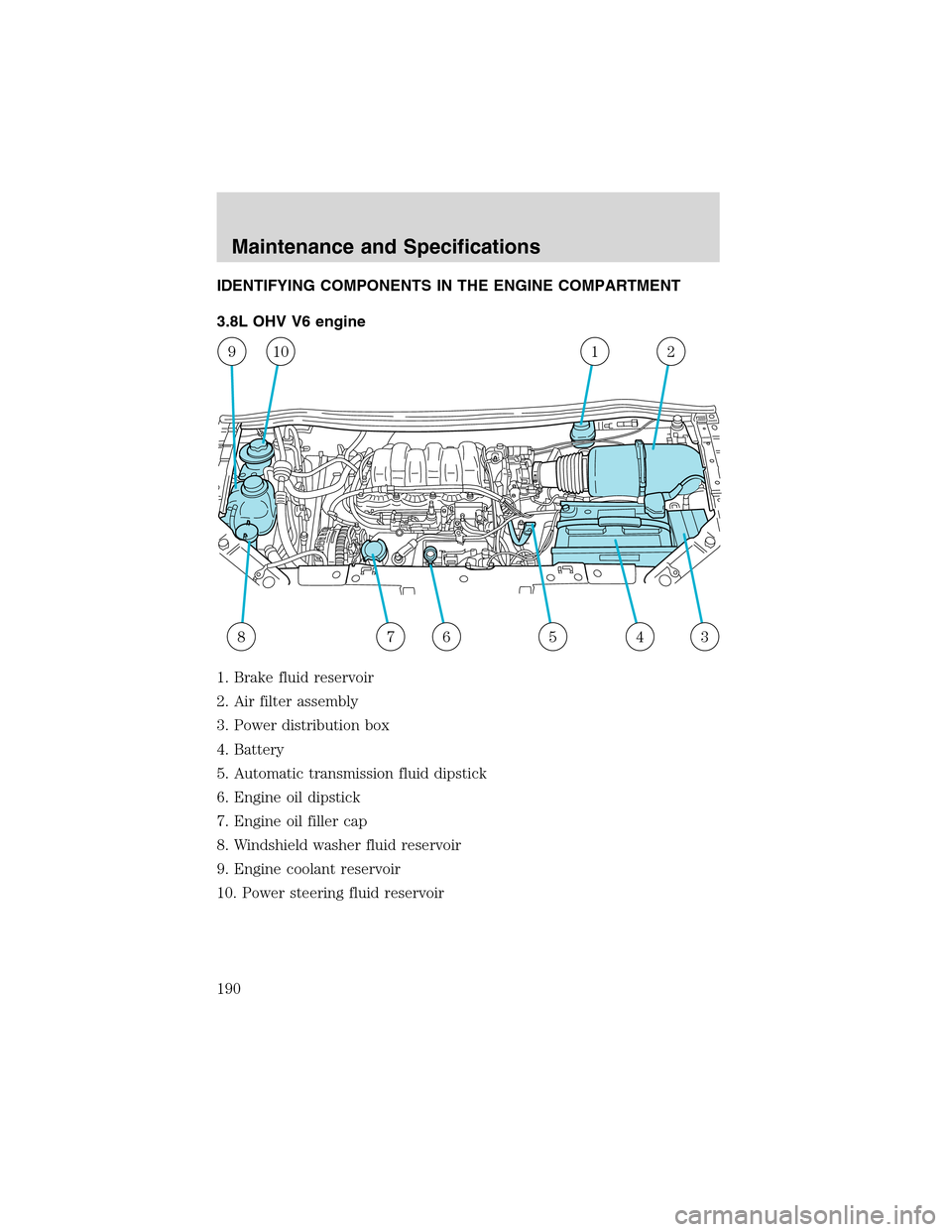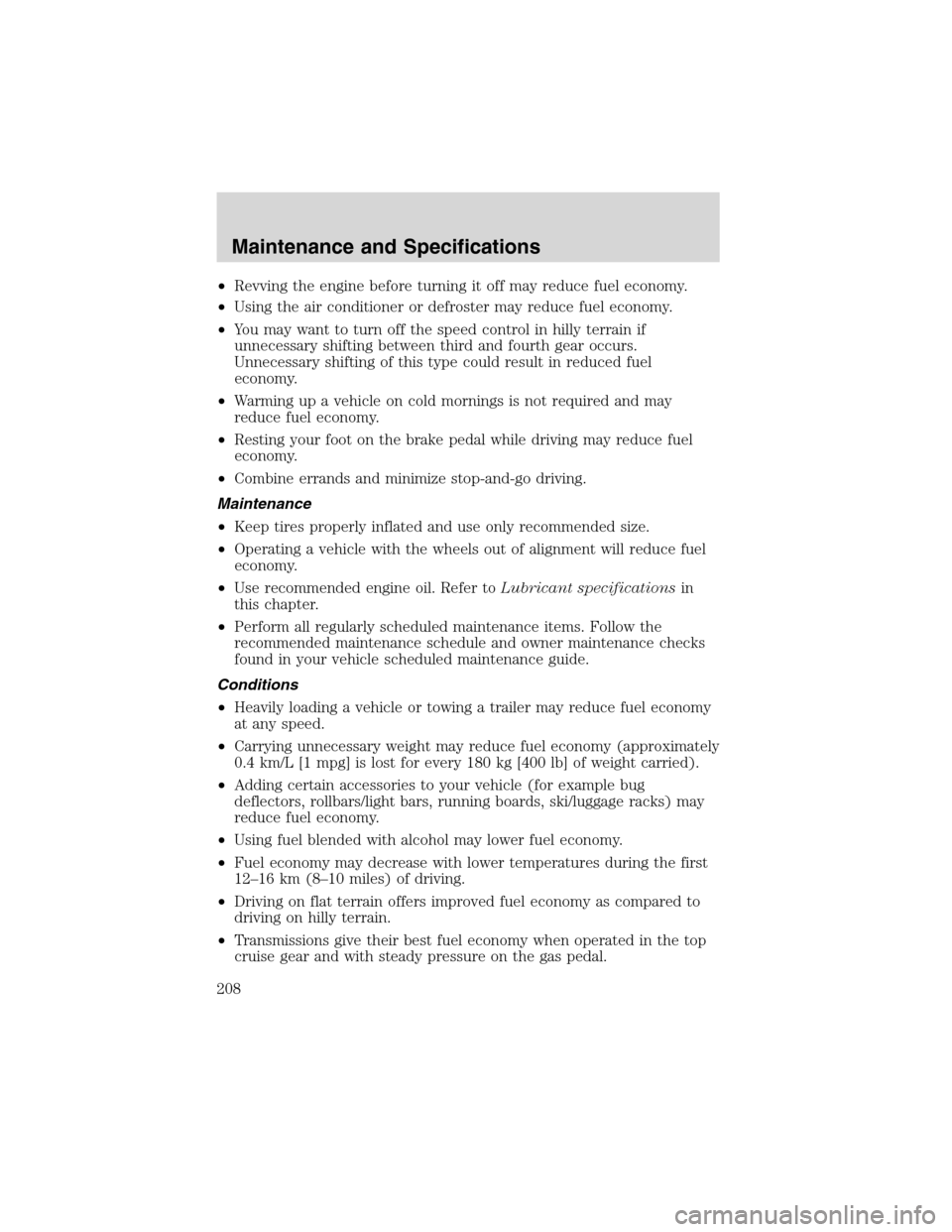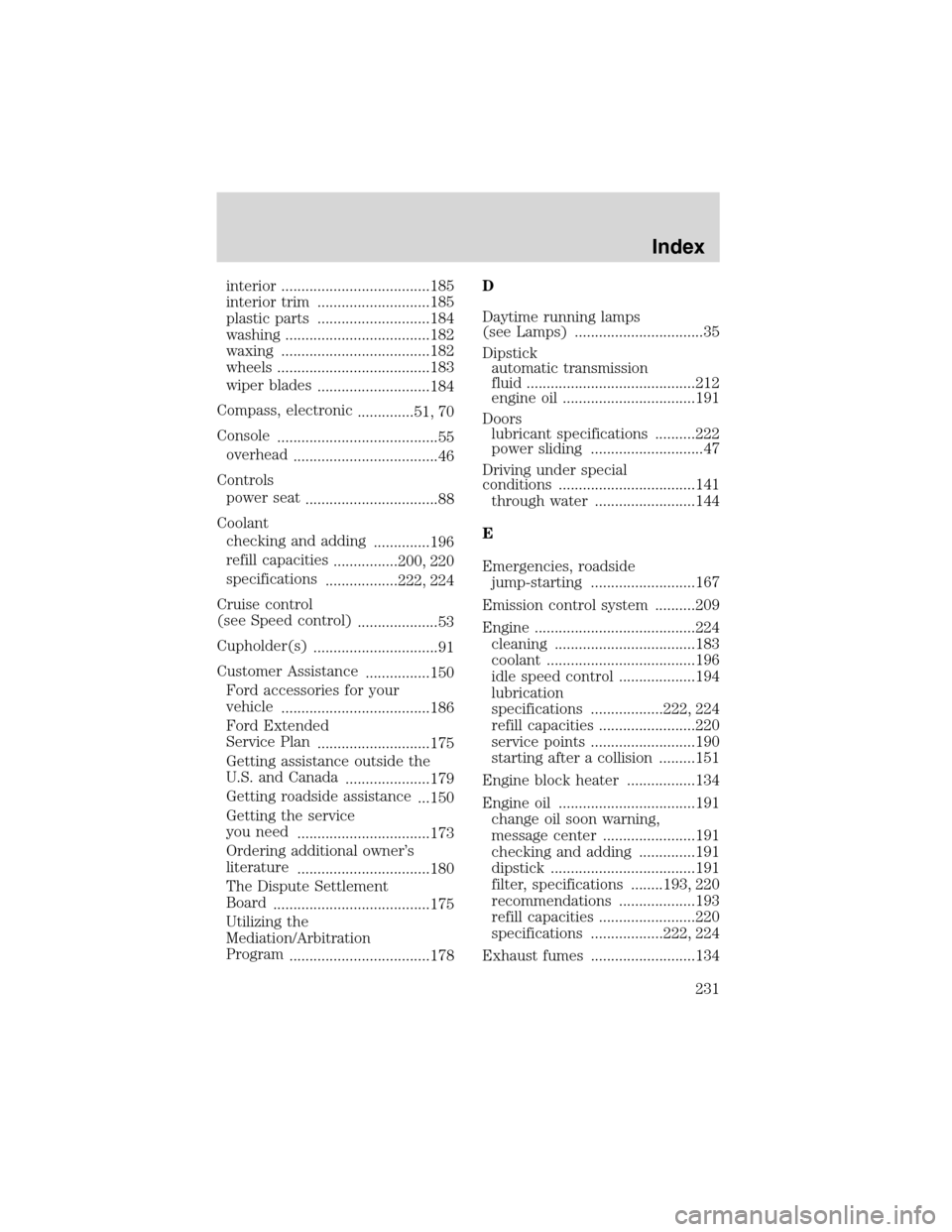2003 FORD WINDSTAR transmission oil
[x] Cancel search: transmission oilPage 2 of 240

Seating and Safety Restraints 87
Seating 87
Safety restraints 98
Air bags 111
Child restraints 117
Driving 131
Starting 131
Brakes 134
Traction control 135
Transmission operation 139
Trailer towing 146
Roadside Emergencies 150
Getting roadside assistance 150
Hazard flasher switch 151
Fuel pump shut-off switch 151
Fuses and relays 152
Changing tires 160
Jump starting 167
Wrecker towing 172
Customer Assistance 173
Reporting safety defects (U.S. only) 181
Cleaning 182
Maintenance and Specifications 188
Engine compartment 190
Engine oil 191
Battery 194
Fuel information 201
Low tire warning system 215
Part numbers 220
Refill capacities 220
Lubricant specifications 222
Table of Contents
2
Page 66 of 240

Liftgate ajar Warning returns after the ignition key
is turned from OFF to ON
Low brake fluid level
Check tail lamps
Check headlamps
Check rear turn lamps
Check front turn lamps
Check cornering/side repeater
lamps (if equipped)
Change oil soon
Oil change required
Check traction control (if
equipped)
Check advancetrac (if
equipped)
Low washer fluid
Check turn signal on reminder
DRIVER’S DOOR AJAR.Displayed when the driver’s door is not
completely closed.
PASSENGER DOOR AJAR.Displayed when the passenger side door is
not completely closed.
DRIVER’S REAR DOOR AJAR.Displayed when the driver’s rear door
is not completely closed.
PASSENGER REAR DOOR AJAR.Displayed when the passenger side
rear door is not completely closed.
LIFTGATE AJAR.Displayed when the liftgate is not completely closed.
CHECK CHARGING SYSTEM.Displayed when the electrical system is
not maintaining proper voltage. If you are operating electrical accessories
when the engine is idling at a low speed, turn off as many of the
electrical loads as soon as possible. If the warning stays on or comes on
when the engine is operating at normal speeds, have the electrical
system checked as soon as possible.
LOW FUEL LEVEL.Displayed as an early reminder of a low fuel
condition.
CHECK TRANSMISSION.Indicates the transmission is not operating
properly. If this warning stays on, contact your dealer as soon as
possible.
Driver Controls
66
Page 156 of 240

Fuse/Relay
LocationFuse Amp
RatingPassenger Compartment Fuse Panel
Description
11 15A Electric brake controller, Brake shift interlock
solenoid, Rear electronic module
12 20A Center high-mounted stop lamp
13 10A Right rear turn lamp, Left stop lamp, Left
rear park lamp
14 10A Autolamp sensor, Transmission overdrive
cancel switch, Front electronic module,
Compass module, Electrochromatic mirror,
PSD overhead console switch
15 20A Console power point
16 10A Cluster
17 20A Cigar lighter/Powerpoint, Datalink connector
18 15A Quarter Window Motors, RH window switch
backlighting, RH lock switch backlighting,
Master control switch (LH) backlighting,
Radio, VCP, Liquid Crystal Display (LCD),
Front electronic module
19 10A Starter interrupt relay (coil)
20—Not used
21—Not used
22 10A Heated Mirrors
23 20A Body power point, Auxiliary blower relay #1
and #2 coils
24—Not used
25 10A Radio (Anti-theft)
26 10A Air bag module, Passenger air bag
deactivated indicator, Passenger seat weight
pressure sensor ECU
27—Not used
28 10A Cluster
29 2A Speed control deactivation switch
Relay 1—Switched system power relay #4
Roadside Emergencies
156
Page 190 of 240

IDENTIFYING COMPONENTS IN THE ENGINE COMPARTMENT
3.8L OHV V6 engine
1. Brake fluid reservoir
2. Air filter assembly
3. Power distribution box
4. Battery
5. Automatic transmission fluid dipstick
6. Engine oil dipstick
7. Engine oil filler cap
8. Windshield washer fluid reservoir
9. Engine coolant reservoir
10. Power steering fluid reservoir
345678
91012
Maintenance and Specifications
190
Page 208 of 240

•Revving the engine before turning it off may reduce fuel economy.
•Using the air conditioner or defroster may reduce fuel economy.
•You may want to turn off the speed control in hilly terrain if
unnecessary shifting between third and fourth gear occurs.
Unnecessary shifting of this type could result in reduced fuel
economy.
•Warming up a vehicle on cold mornings is not required and may
reduce fuel economy.
•Resting your foot on the brake pedal while driving may reduce fuel
economy.
•Combine errands and minimize stop-and-go driving.
Maintenance
•Keep tires properly inflated and use only recommended size.
•Operating a vehicle with the wheels out of alignment will reduce fuel
economy.
•Use recommended engine oil. Refer toLubricant specificationsin
this chapter.
•Perform all regularly scheduled maintenance items. Follow the
recommended maintenance schedule and owner maintenance checks
found in your vehicle scheduled maintenance guide.
Conditions
•Heavily loading a vehicle or towing a trailer may reduce fuel economy
at any speed.
•Carrying unnecessary weight may reduce fuel economy (approximately
0.4 km/L [1 mpg] is lost for every 180 kg [400 lb] of weight carried).
•Adding certain accessories to your vehicle (for example bug
deflectors, rollbars/light bars, running boards, ski/luggage racks) may
reduce fuel economy.
•Using fuel blended with alcohol may lower fuel economy.
•Fuel economy may decrease with lower temperatures during the first
12–16 km (8–10 miles) of driving.
•Driving on flat terrain offers improved fuel economy as compared to
driving on hilly terrain.
•Transmissions give their best fuel economy when operated in the top
cruise gear and with steady pressure on the gas pedal.
Maintenance and Specifications
208
Page 231 of 240

interior .....................................185
interior trim ............................185
plastic parts ............................184
washing ....................................182
waxing .....................................182
wheels ......................................183
wiper blades
............................184
Compass, electronic
..............51, 70
Console
........................................55
overhead
....................................46
Controls
power seat
.................................88
Coolant
checking and adding
..............196
refill capacities
................200, 220
specifications
..................222, 224
Cruise control
(see Speed control)
....................53
Cupholder(s)
...............................91
Customer Assistance
................150
Ford accessories for your
vehicle
.....................................186
Ford Extended
Service Plan
............................175
Getting assistance outside the
U.S. and Canada
.....................179
Getting roadside assistance
...150
Getting the service
you need
.................................173
Ordering additional owner’s
literature
.................................180
The Dispute Settlement
Board
.......................................175
Utilizing the
Mediation/Arbitration
Program
...................................178D
Daytime running lamps
(see Lamps) ................................35
Dipstick
automatic transmission
fluid ..........................................212
engine oil .................................191
Doors
lubricant specifications ..........222
power sliding ............................47
Driving under special
conditions ..................................141
through water .........................144
E
Emergencies, roadside
jump-starting ..........................167
Emission control system ..........209
Engine ........................................224
cleaning ...................................183
coolant .....................................196
idle speed control ...................194
lubrication
specifications ..................222, 224
refill capacities ........................220
service points ..........................190
starting after a collision .........151
Engine block heater .................134
Engine oil ..................................191
change oil soon warning,
message center .......................191
checking and adding ..............191
dipstick ....................................191
filter, specifications ........193, 220
recommendations ...................193
refill capacities ........................220
specifications ..................222, 224
Exhaust fumes ..........................134
Index
231